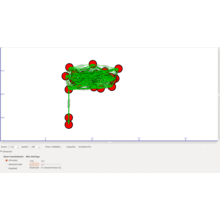Tag Archive: 'ns3 simulator'
The popularity of highly resonant, loosely coupled, wireless energy transfer systems operating at 6.78 MHz has increased dramatically over the last few years. In this paper we present the zero voltage switching (ZVS) voltage mode class D amplifier topology and evaluate its performance as a suitable A4WP Class-3 compliant amplifier using eGaN FETs and compare the performance […]
This paper presents a chronological review of the research carried out on antennas in low-temperature cofired ceramics (LTCC) technology over the last ten years or so. Major breakthroughs in LTCC technologies and its shortcomings are highlighted. The current state of the art of LTCC-technology-based antennas is then evaluated. All realizable features of the LTCC-based antennas, […]
In this paper, we propose area transmission efficiency to evaluate the performance of single-user multiple-input multiple-output (SU-MIMO) and multi-user MIMO (MU-MIMO) in wireless mesh networks (WMNs). The area transmission efficiency is the number of packets that can be transmitted per unit time and per area, and is calculated by considering the multiplexing effect of MIMO and the […]
This paper investigates power allocation for reliable downlink transmission in cellular networks subject to quality-of-service (QoS) constraints. The reliability of data transmissions is assured by hybrid automatic repeat request protocol with incremental redundancy (HARQ-IR). By developing and evaluating the effective throughput of the HARQ-IR protocol for the downlink transmission under buffer-limited QoS constraints, we propose […]
Validation of ad hoc network mobility models almost depends on simulation. However, most of the widely used models are currently very simple and they focus on the ease of implementation rather than soundness of establishment. As an outcome, simulation based mobility models are often randomly generated movement patterns. Various simulators are available to mimic the movement of wireless nodes […]
Content downloading from vehicles is becoming increasingly popular, but it also meets challenges dueto the limited number of road-side units (RSUs) and the expensive cost of 3G/LTE downloads. Cooperative LTE + vehicle-to-vehicle (V2V) downloading schemes can significantly improve the efficiency and reduce costs. However, selfish users are motivated to minimize their own LTE downloading costs, so they would […]
This paper introduces a novel and efficient approach for user cooperation in wireless video multicast using randomized distributed space time codes (R-DSTC), in which the sender first transmits the source packets, and the sender and receivers that have received all source packets then generate and send the parity packets simultaneously using R-DSTC. As more parity […]
In mobile social networks (MSN), with the aim of conserving limited resources, egotistic nodes might refuse to forward messages for other nodes. Different from previous work which mainly focuses on promoting cooperation between selfish nodes, we consider it from a more pragmatic perspective in this paper. Be specific, we regard selfishness as a native attribute of a system and […]
Name resolution is at the heart of Information-Centric Networking (ICN), where names are used to both identify information and/or services, and to guide routing and forwarding inside the network. The ICN focus on information, rather than hosts, raises significant concerns regarding the scalability of the required Name Resolution System (NRS), especially when considering global scale, inter-domain deployments. In the route-by-name approach to NRS construction, […]
This paper focuses on incentivizing cooperative behavior in community-based autonomous networkingenvironments (like mobile social networks, etc.), in which through dynamically forming virtual and/or physical communities, users voluntarily participate in and contribute resources (or provide services) tothe community while consuming. Specifically, we proposed a simple but effective EGT (Evolutionary Game Theory)-based mechanism, VPEF (Voluntary Principle and round-based Entry Fee), to drive […]

 Click Here to watch our latest output video using NS3 simulator
Click Here to watch our latest output video using NS3 simulator  Click Here to watch our latest projects screenshots using NS3 simulator
Click Here to watch our latest projects screenshots using NS3 simulator